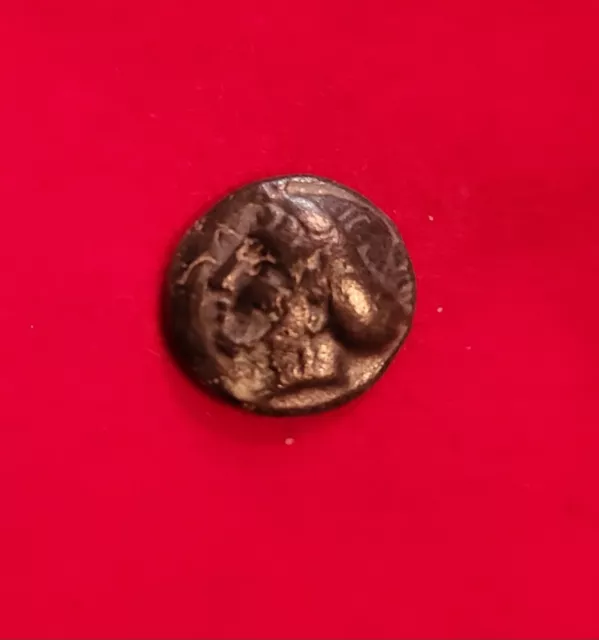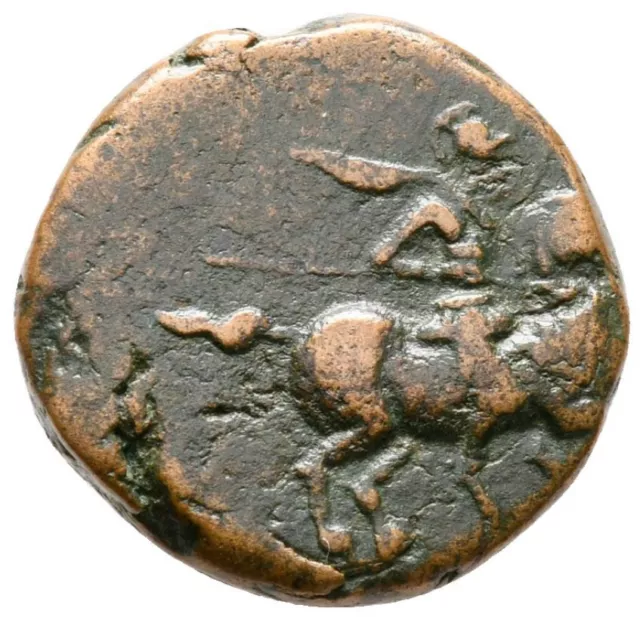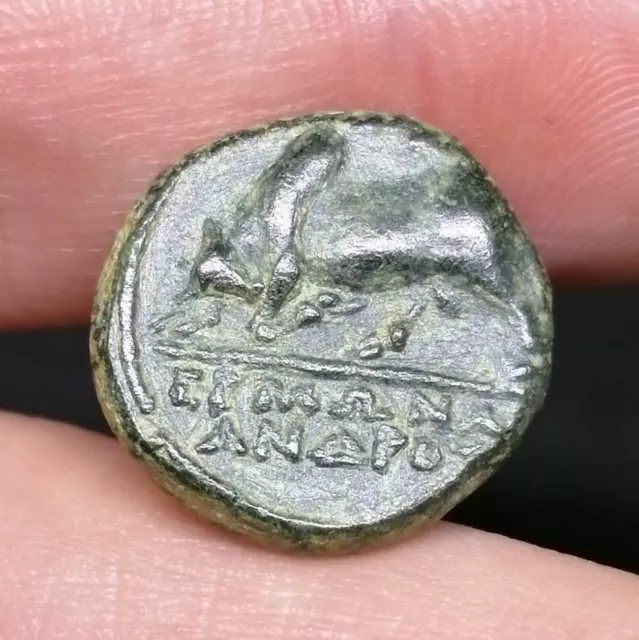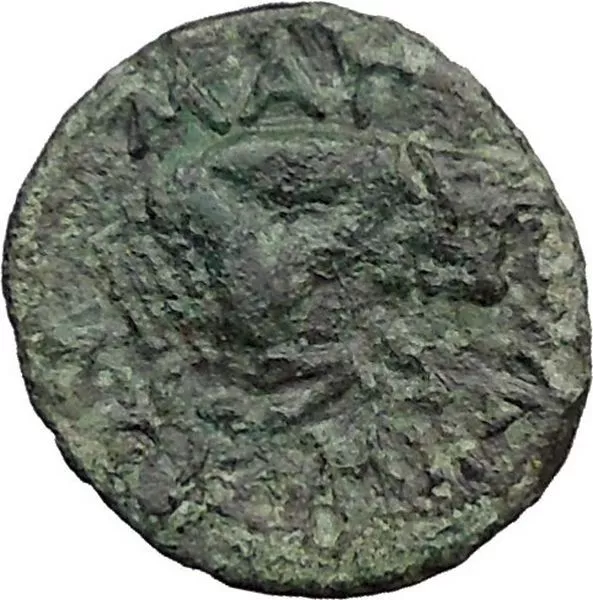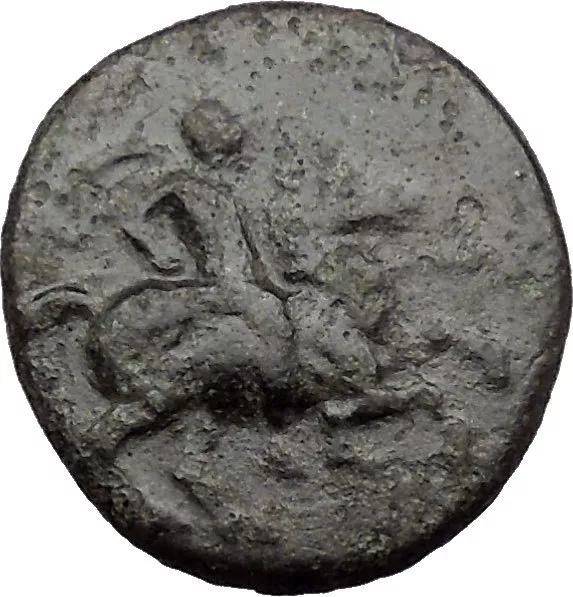|
Greek City of Magnesia (ad Maeandrum) in Ionia
Bronze 17mm (4.24 grams) Struck circa 350-200 B.C.
Klearchos, magistrate
Reference: Sear 4487 var.; SNG Copenhagen 813
Armed horseman prancing right, holding couched spear.
Humped bull butting left, MAΓN above, ΚΛΕΑΡΧΟΣ and
grain ear left in exergue;
all within maeander pattern border.
Situated south-east of Ephesus, on a tributary of the Maeander,
Magnesia was originally founded from Thessaly but was re-established by
colonists from Miletos in the 7th century B.C.
You are bidding on the exact item pictured,
provided with a Certificate of Authenticity and Lifetime Guarantee of
Authenticity.
Magnesia
,
deriving from the tribe name
Magnetes
,
is the name of the southeastern area of
Thessaly
in
central Greece
.
The modern prefecture (�ομός Μαγνησίας) was created in 1947 out of the Larissa
prefecture. About 70% of the population live in the Greater
Volos
area which
is the second-largest city in Thessaly and the third busiest commercial port in
Greece. Much of the population lives near the
Pagasetic Gulf
and in the eastern part. The chemical element,
Magnesium
,
was named after the "City of Magnesia" by Sir Humphrey Davy in 1808[citation
needed ]
The capital of Magnesia prefecture is the metropolitan city of
Volos
. According
to the most recent census (2001), the population stands at 207,000. The
prefecture of Magnesia includes the
Northern
Sporades
group of islands (Skiathos,
Skopelos
and Alonissos
.
The prefecture also includes the
Alonissos Marine Park
. The prefecture hosts 2,000,000 tourists annually.
Magnesia is represented in the
Greek Parliament
by five members.
//
Geography
The natural landscape of Magnesia consists of wooded mountains, cultivated
flat land, and coastline. One of the area's main elements is the
Pelion
mountain
range which is located the eastern region of the Prefecture and forms the
eastern edge of the
Pagasetic Gulf
.
The ranges' highest peak is
Pourianos Stavros
or Xeforti, (altitude 1624 metres). On the edge of
Magnesia
peninsula
Tiseo
mountain is found, which is considered to be the Southeast edge of
Pelion
.
Mt.
Maurovouni
(1054 metres) is the northeastly most mountain of the prefecture
and extends to the neighboring prefecture of
Larissa
.
The southwest border of the prefecture is Mt.Othry,
with its highest peak called
Gerakovouni
(1726 metres) and forms the boundary with the prefecture of
Phthiotis
.
The interior of Magnesia has two plains. One found between Mt. Halkodonio
(725 metres) and Othry is called
Almyros
plain
, while the
other between Halkodonio and
Pelion
is
called the Volos
-Velestino
plain. The hydrological network of the prefecture is not particularly rich and
is characterized by the absence of big
rivers
. The waters coming from
Pelion
shape
the rivers Anavros
, Platanorema, and Xirias.
In the North
section of the prefecture
Lake Karla
was formerly found. Lake Karla was drained in 1962, but attempts have been made
for its partial restoration.
On the bight of Sourpi
, next to
Amaliapolis
a coastal
wetland
is
found, with various species of
migratory birds
. This wetland together with the forest of
Kouri
- an
infrequent lowland
of Oak
tree forest
close to Almyros
- is included in the list of the protected regions of the
European
Network Natura 2000
.
The
Pagasetic Gulf
dominates the interior coastline of Magnesia.
Climate
The average
temperature
is 17
degrees Celsius
and the average rainfall about 540 millimetres per year.
Heat waves and intense cold periods are rare. During the summer the temperature
rises up to about 37 to 38 °C in August. The climate varies in different parts
of the prefecture; close to the
Pagasetic Gulf
conditions are humid, in
Nea Ionia
it is quite dry and in
Velestino
and Almyros
is the climate is continental. In winter there is significant
snowfall in the mountains and often freezing temperatures.
History
Antiquity
According to Hesiod
's (probably) "Eoiae" (Greek:
Ηοίαι ) or "Catalogue
of Women"[2]
on the origin of the
Greeks
, Pandora
(named after her grandmother
Pandora
,
sister of Hellen
and daughter of
Deukalion
and Pyrrha
) together with Zeus had one son
Graecus
,
while Zeus had two more with
Thyia
, another of
Deukalion's daughter:
Magnes
and
Macedon
. Magnes and Makednos together with
Hellen
's three
sons Dorus
,
Xuthus
(with
his sons
Ion
and
Achaeus
) and
Aeolos
, comprised the set of progenitors of the ancient tribes that formed
the Greek
/Hellenic
nation. Magnes ruled the area and people under his name. Magnesia is also
homeland of the mythical heroes
Jason
,
Peleus
and his
son Achilles
.
The word magnet
comes from the Greek "magnÃtis lÃthos" (μαγνήτης λίθος), which means "magnesian
stone". The names for the elements
magnesium
and manganese
are also derived from this region, which in addition to the magnetic magnetite
(an iron ore), produces certain ores of magnesium and manganese that were known
to alchemists. The Magnetes contributed to the
Greek colonization
, with their main colonies being established before the
7th century BC, under the names of Magnesia beside Sipylus in Lydia and Magnesia
on the Maeander in Ionia.
Christian
era
Written accounts and remains from the 5th century AD document the appearance
of Christianity in Magnesia. The minutes of the 3rd Ecumenical Conference are
co-signed by the Bishop of Dimitriada Cleonikos. Five basilicas have been
revealed in Nea Anhialos, showing that the area was undergoing a spiritual
growth in that era. Magnesias has churches, monasteries and chapels, many of
which are architectural masterpieces in the style that is called "Pelioritica".
In the area of Pelion are the monastery of Saint Yerasimos in Makrinitsa, The
Holy Archangels in Agios Georgios Nilias, Osios Lavredios in Agios Lavrendis,
Saint John the Baptist in Siki and Saint Spiridon in Promiri. The most famous is
the Monastery in Flamouri, built in the 16th century by Osios Simeon, the
so-called "barefoot and loin-clothed", located above Veneto.
In the Almiros area and on the mountain of Othris two other monasteries were
built, one inhabited by
monks
in Ano Pagania (Virgin Mary) Xenia and the other by
nuns
in Kato Panagia Xenia. This monastery holds historical monuments of the
area from the 12th century, with of frescoes, treasuries and a library. In Kato
Panagia Xenia monastery, an icon of the Virgin Mary, venerated by the people of
the area, is kept. All the monasteries are of archeological, historical and
artistic interest and are accessible (the one in Flamouri only by men).
Ionia is an ancient region of central coastal
Anatolia
in present-day
Turkey
, the region nearest
Ä°zmir
, which was historically
Smyrna
. It consisted of the northernmost
territories of the
Ionian League
of
Greek
settlements. Never a unified state, it
was named after the
Ionian tribe
who, in the
Archaic Period
(800–480 BC), settled mainly the
shores and islands of the
Aegean Sea
. Ionian states were identified by
tradition and by their use of
Eastern Greek
.
Ionia proper comprised a narrow coastal strip from
Phocaea
in the north near the mouth of the
river Hermus
(now the
Gediz
), to
Miletus
in the south near the mouth of the
river
Maeander
, and included the islands of
Chios
and
Samos
. It was bounded by
Aeolia
to the north,
Lydia
to the east and
Caria
to the south. The cities within the
region figured large in the strife between the
Persian Empire
and the Greeks.
According to
Greek
tradition, the cities of Ionia were
founded by
colonists
from the other side of the Aegean.
Their settlement was connected with the legendary history of the Ionic people in
Attica
, which asserts that the colonists were
led by Neleus and Androclus, sons of
Codrus
, the last
king of Athens
. In accordance with this view
the "Ionic migration", as it was called by later chronologers, was dated by them
one hundred and forty years after the
Trojan war
, or sixty years after the return of
the Heracleidae
into the
Peloponnese
.
Geography
Physical
Ionia was of small extent, not exceeding 150 kilometres (90 mi) in length
from north to south, with a breadth varying from 60 to 90 kilometres (40 to 60
mi), but to this must be added the peninsula of
Mimas
, together with the two islands. So
intricate is the coastline that the voyage along its shores was estimated at
nearly four times the direct distance. A great part of this area was, moreover,
occupied by mountains. Of these the most lofty and striking were Mimas and
Corycus, in the peninsula which stands out to the west, facing the island of
Chios;
Sipylus
, to the north of Smyrna, Corax,
extending to the south-west from the Gulf of Smyrna, and descending to the sea
between Lebedus and Teos; and the strongly marked range of
Mycale
, a continuation of Messogisin the
interior, which forms the bold headland of Trogilium or Mycale, opposite Samos.
None of these mountains attains a height of more than 1,200 metres (3,940 ft).
The district comprised three extremely fertile valleys formed by the outflow of
three rivers, among the most considerable in Asia Minor: the
Hermus
in the north, flowing into the
Gulf of Smyrna
, though at some distance from
the city of that name; the Caster, which flowed under the walls of Ephesus; and
the
Maeander
, which in ancient times discharged its
waters into the deep gulf that once bathed the walls of Miletus, but which has
been gradually filled up by this river's deposits. With the advantage of a
peculiarly fine climate, for which this part of
Asia Minor
has been famous in all ages, Ionia
enjoyed the reputation in ancient times of being the most fertile of all the
rich provinces of Asia Minor; and even in modern times, though very imperfectly
cultivated, it produces abundance of fruit of all kinds, and the
raisins
and
figs
of Smyrna supply almost all the markets of
Europe. (Needs citation. The above description reads to be a verbatum quote from
an Englishman's travelogue.)
Political
The geography of Ionia placed it in a strategic position that was both
advantageous and disadvantageous. Ionia was always a maritime power founded by a
people who made their living by trade in peaceful times and marauding in
unsettled times. The coast was rocky and the arable land slight. The native
Luwians for the most part kept their fields further inland and used the rift
valleys for wooded pasture. The coastal cities were placed in defensible
positions on islands or headlands situated so as to control inland routes up the
rift valleys. The people of those valleys were of different ethnicity. The
populations of the cities were multi-cultural and received cultural stimuli from
many civilizations in the eastern
Mediterranean
, which resulted in a brilliant
society able to make contributions of worldwide and millennial significance.
On the other hand Ionia was divided by the Aegean Sea from the mother country
and could seldom be defended from there. Many imperial powers arose inland
against which Ionia was forced to defend itself and to whom it was typically
required finally to submit.
Demography
Ancient demographics are available only from literary sources.
Herodotus
states that in Asia the Ionians kept
the division into twelve cities that had prevailed in Ionian lands of the north
Peloponnese, their former homeland, which became
Achaea
after they left.These Asian cities were
(from south to north)
Miletus
,
Myus, Priene
,
Ephesus
,
Colophon
,
Lebedos
,
Teos,
Erythrae
,
Clazomenae
and
Phocaea
, together with
Samos
and
Chios
.
Smyrna
, originally an
Aeolic
colony, was afterwards occupied by
Ionians from Colophon, and became an Ionian city — an event which had taken
place before the time of Herodotus.These cities do not match those of
Achaea
. Moreover, the Achaea of Herodotus' time
spoke Doric
(Corinthian), but in
Homer
it is portrayed as being in the kingdom
of Mycenae
, which most likely spoke
Mycenaean Greek
, which is not Doric. If the
Ionians came from Achaea, they departed during or after the change from East
Greek to West Greek there. Mycenaean continued to evolve in a pocket,
Arcadia
.
There is no record of any people named Ionians in
Late Bronze Age
Anatolia but
Hittite texts
record the Achaeans of
Ahhiyawa
, of location not completely certain,
but in touch with the Hittites of that time.
Miletus
and some other cities founded earlier
by non-Greeks received populations of
Mycenaean Greeks
probably under the name of
Achaeans. The tradition of Ionian colonizers from Achaea suggests that they may
have been known by both names even then. In the absence of archaeological
evidence of discontinuity at Miletus the Achaean population whatever their name
appears to have descended to archaic Ionia, which does not exclude the
possibility of another colonizing and founding event from Athens.
Herodotus expresses some impatience at the ethnic views of his countrymen
concerning Ionia: "for it would be foolishness to say that these are more truly
Ionian or better born ...."[5]
He lists other ethnic populations among the settlers: Abantes from
Euboea
,
Minyans
from
Orchomenus
, Cadmeians,
Dryopians
,
Phocians
,
Molossians
, Arcadian
Pelasgians
,
Dorians
of
Epidaurus
, and others. The presence of Doric
Ionians is somewhat contradictory, but Herodotus himself, a major author of the
Ionic dialect, was from a Doric city,
Halicarnassus
. Even " the best born of the
Ionians", the Athenians, married girls from
Caria
. "Yet since they set more store by the
name than the rest of the Ionians, let it be granted that those of pure birth
are Ionians."[6]
History
Greek city-unions in Anatolia, Blue are Ion cities
From the 18th century BC the region was a part of the
Hittite Empire
with possible name
Arzawa
,which was destroyed by invaders during
the 12th century BC together with the collapse of the Empire. Ionia was settled
by the Greeks probably during the 11th century BC. The most important city was
Miletus
(the Milawanta of Hittites).
Several centuries later Ionia was the place where western philosophy began and
was the homeland of
Heraclitus
,
Thales
,
Anaximander
and
Anaximenes
. They were natural-philosophers of
the Ionian school of philosophy and tried to explain the phenomena according to
no-supernatural laws. They also searched a simple material-form behind the
appearances of things (origin) and this conception had a great influence on the
early archaic art in Greece.
Settlement
During the late 13th century BC the peoples of the
Aegean Sea
took to marauding and resettling as
a way of life and were called by the Egyptians the
Sea Peoples
.[citation
needed ] Mycenaean Greeks must have been among them.
They settled lightly on the shores of
Luwian
Anatolia often by invitation. In the
background was the stabilizing influence of the Hittites, who monitored maritime
movement and suppressed piracy. When that power was gone the Luwian people
remained in the vacuum as a number of coastal splinter states that were scarcely
able now to defend themselves. Ionian Greeks took advantage of opportunities for
coastal raiding: an inscription of
Sargon II
(ca 709-07,recording a naval
expedition of 715) boasts "in the midst of the sea" he had "caught the Ionians
like fish and brought peace to the land of Que
Cilicia
and the city of
Tyre
". For a full generation earlier Assyrian
inscriptions had recorded troubles with the Ionians, who escaped on their boats.[7]
Caria
and
Lycia
came to the attention of
Athens
, most powerful state remaining in
Greece, which also had lost its central government ruling from
Mycenae
, now burned and nearly vacant. Ionians
had been expelled from the
Peloponnesus
by the
Dorians
and had sought refuge in Athens. The
Athenian kings decided to relieve the crowding by resettling the coast of Lydia
with Ionians from the Peloponnesus under native Athenian leadership.
They were not the only Greeks to have such a perception and reach such a
decision. The Aeolians
of
Boeotia
contemporaneously settled the coast to
the north of the Ionians and the newly arrived
Dorians
of
Crete
and the islands the coast of
Caria
. The Greeks descended on the
Luwians
of the Anatolian coast in the 10th
century BC. The descent was not peaceful and the Luwians were not willing.
Pausanias
gives a thumbnail sketch of the
resettlement.[8]
Miletus
was the first city attacked, where
there had been some Mycenaean Greeks apparently under the rule of
Cretans
. After overthrowing the Cretan
government and settling there the Ionians widened their attack to
Ephesus
,
Samos
and
Priene
. Combining with
Aeolians
from
Thebes
they founded
Myus.
Colophon
was already in the hands of Aeolians
who had arrived via Crete in Mycenaean times. The Ionians "swore a treaty of
union" with them. They took
Lebedos
driving out the Carians and augmented
the Aeolian population of
Teos. They settled on
Chios
, took
Erythrae
from the Carians, Pamphylians (both
Luwian) and Cretans.
Clazomenae
and
Phocaea
were settled from
Colophon
. Somewhat later they took
Smyrna
from the Aeolians.
Brief autonomy
The Ionian cities formed a religious and cultural (as opposed to a political
or military) confederacy, the
Ionian League
, of which participation in the
Panionic festival
was a distinguishing
characteristic. This festival took place on the north slope of
Mt. Mycale
in a shrine called the
Panionium
. In addition to the Panionic festival
at Mycale, which was celebrated mainly by the Asian Ionians, both European and
Asian coast Ionians convened on
Delos
Island each summer to worship at the
temple of the Delian
Apollo
.
But like the
Amphictyonic league
in Greece, the Ionic was
rather of a sacred than a political character; every city enjoyed absolute
autonomy, and, though common interests often united them for a common political
object, they never formed a real confederacy like that of the Achaeans or
Boeotians
. The advice of
Thales
of Miletus to combine in a political
union was rejected.
The colonies naturally became prosperous.
Miletus
especially was at an early period one
of the most important commercial cities of Greece; and in its turn became the
parent of numerous other colonies, which extended all around the shores of the
Euxine Sea
and the Propontis from Abydus and
Cyzicus
to
Trapezus
and Panticapaeum.
Phocaea
was one of the first Greek cities whose
mariners explored the shores of the western Mediterranean.
Ephesus
, though it did not send out any
colonies of importance, from an early period became a flourishing city and
attained to a position corresponding in some measure to that of Smyrna at the
present day.
Under the
last Anatolian empire
About 700 BC
Gyges
, first Mermnad king of
Lydia
, invaded the territories of Smyrna and
Miletus, and is said to have taken
Colophon
as his son Ardys did Priene. The first
event in the history of Ionia for which there is a trustworthy account is the
inroad of the
Cimmerii
, who ravaged a great part of Asia
Minor, including Lydia, and sacked
Magnesia on the Maeander
, but were foiled in
their attack upon Ephesus. This event may be referred to the middle of the 7th
century BC. It was not until the reign of
Croesus
(560–545 BC) that the cities of Ionia
fell completely under Lydian rule.
Satrapy of the
Achaemenids
The defeat of Croesus by
Cyrus
was followed by the conquest of all the
Ionian cities. These became subject to the Persian monarchy with the other Greek
cities of Asia. In this position they enjoyed a considerable amount of autonomy,
but were for the most part subject to local despots, most of whom were creatures
of the Persian king. It was at the instigation of one of these despots,
Histiaeus of Miletus
, that in about 500 BC the
principal cities ignited the
Ionian Revolt
against Persia. They were at
first assisted by the Athenians and
Eretria
, with whose aid they penetrated into
the interior and burnt Sardis, an event which ultimately led to the
Persian invasion of Greece
. But the fleet of
the Ionians was defeated off the island of
Lade
, and the destruction of Miletus after a
protracted siege was followed by the reconquest of all the Asiatic Greeks,
insular as well as continental.
Autonomy
under the Athenian empire
The victories of the Greeks during the great Persian war had the effect of
enfranchising their kinsmen on the other side of the Aegean; and the
battle of Mycale
(479 BC), in which the defeat
of the Persians was in great measure owing to the Ionians, secured their
emancipation. They henceforth became the dependent allies of Athens (see
Delian League
), though still retaining their
autonomy, which they preserved until the
peace of Antalcidas
in 387 BC once more placed
them as well as the other Greek cities in Asia under the nominal dominion of
Persia.
Satrapy again
Ionian cities appear to have retained a considerable amount of freedom until
the invasion of Asia Minor by
Alexander the Great
.
Hellenistic period
After the
battle of the Granicus
most of the Ionian
cities submitted to the rule of
Alexander III
of
Macedon
and his
Diadochi
. As such Ionia enjoyed a great
prosperity during the
Hellenistic
times with the notable exception of
Miletus
, which, being the only city of the
Ionian League
to deny to pay homage to
Alexander
, was finally leveled after a long
siege at 334
BC
, and never restored to its previous
splendor.
Under Rome
Ionia became part of the Roman province of Asia.
Legacy
Ionia has laid the world under its debt not only by giving birth to a long
roll of distinguished men of letters and science (notably the
Ionian School
of philosophy), but also by
originating the distinct school of art which prepared the way for the brilliant
artistic development of Athens in the 5th century BC. This school flourished
between 700 and 500 BC, and is distinguished by the fineness of workmanship and
minuteness of detail with which it treated subjects, inspired always to some
extent by non-Greek models. Naturalism is progressively obvious in its
treatment, e.g. of the human figure, but to the end it is still subservient to
convention. It has been thought that the Ionian
migration
from Greece carried with it some part
of a population which retained the artistic traditions of the
Mycenaean civilization
, and so caused the birth
of the Ionic school; but whether this was so or not, it is certain that from the
8th century BC onwards we find the true spirit of Hellenic art, stimulated by
commercial intercourse with eastern civilizations, working out its development
chiefly in Ionia and its neighbouring isles. The great names of this school are
Theodorus
and Rhoecus of Samos;
Bathycles
of
Magnesia on the Maeander
;
Glaucus of Chios
, Melas, Micciades, Archermus,
Bupalus and Athenis
of
Chios
. Notable works of the school still extant
are the famous archaic female statues found on the Athenian Acropolis in
1885–1887, the seated statues of Branchidae, the Nike of Archermus found at
Delos, and the objects in
ivory
and
electrum
found by D.G. Hogarth in the lower
strata of the Artemision at Ephesus.
The
Arabic
,
Turkish
,
Persian
and
Urdu
name for
Greek
is Younan (یونان), a
transliteration of "Ionia." The same is true for the
Hebrew
word, "Yavan" (יוון) and the
Sanskrit
word "yavana ".
Not to be confused with the meaning of the Assyrian name Younan (also spelled,
Yonan), a transliteration of Jonah, from the Aramaic and Hebrew, "Yonah",
meaning dove or peace.
This entry was originally from the
1911 Encyclopædia Britannica
.
|
